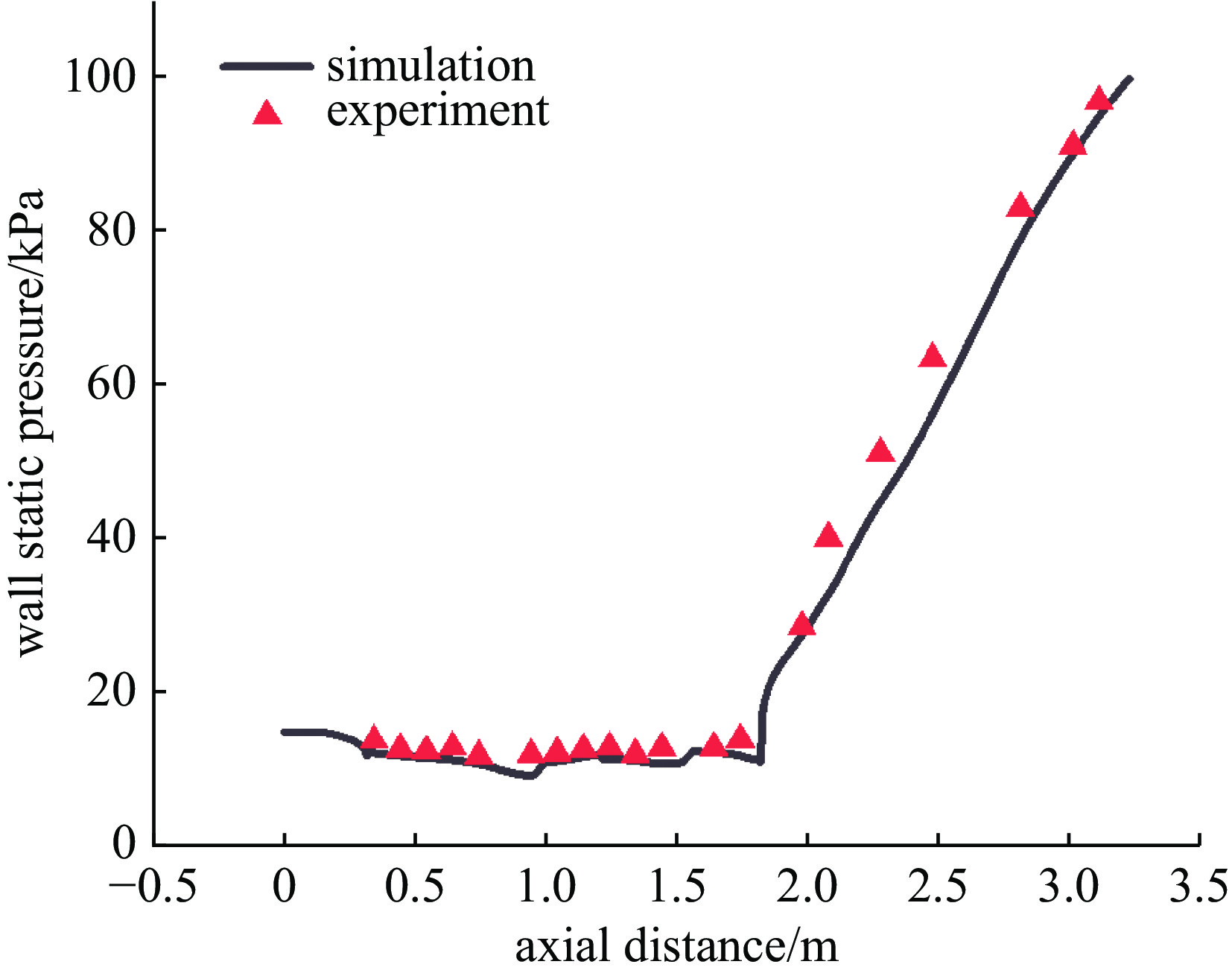Simulation and experimental characteristics of supersonic center ejector
-
摘要: 与真空罐系统相比,超声速引射技术在化学激光器压力恢复方面有着显著优势,其中超声速中心引射器由于总压损失更小引射潜力更大。对超声速中心引射器流动特性分别进行了数值仿真与试验研究。结果表明:对于带收缩型混合室的超声速中心引射器,尽管其更易达到工作状态,然而在固定引射系数且以维持较低盲腔压力条件下,前者并不优于等直型引射器。在变引射系数(固定二次流质量流率)条件下,混合室面积缩比每提高0.05,一次流质量流率约提高0.3 kg/s才能使其达到临界启动状态。超声速引射器在临界启动状态时整体引射性能达到最高。在抽盲腔能力方面,单级超声速中心型引射器明显强于其他类型引射器,最低可达1.3 kPa。Abstract: Compared with vacuum tank system, supersonic injection technology has significant advantages in pressure recovery of chemical laser weapons, among them, the supersonic center injector has greater injection potential due to its smaller total pressure loss. Simulation and experimental studies were conducted on the supersonic center injector. The results show that for the supersonic center injector with a contraction-type mixing chamber, although it is easier to reach the working state, it is not superior to the straight-type injector under the condition of fixed injection coefficient and maintaining a lower blind cavity pressure. Under the condition of variable injection coefficient (fixed secondary mass flow rate), for every 0.05 increase in the area contraction ratio of the mixing chamber, the primary mass flow rate needs to be increased by approximately 0.3 kg/s to reach the critical start-up state. The overall injection performance of the supersonic injector reaches its highest when it is at the critical start-up state. In terms of blind cavity extraction capability, the single-stage supersonic center injector is significantly superior to other types of injectors, with a minimum of 1.3 kPa achievable.
-
表 1 不同收缩比下增压比发展
Table 1. Development of boost ratio under Different Shrinkage Ratios
shrinkage
ratiototal pressure at the secondary
outlet/Paback pressure at the
outlet/Papressure increase
ratio0.60 15193 99783 6.57 0.65 14902 100278 6.73 0.70 14586 99573 6.83 0.75 14369 99833 6.95 0.80 14145 99779 7.05 表 2 仿真工况设置
Table 2. Simulation condition settings
boundary mass flow rate/(kg/s) temperature/K pressure/kPa one flow inlet 3.40~4.70 300 3400 secondary inlet 0.72 300 11 export − − 100 表 3 超声速引射器启动时盲腔压力
Table 3. Blind chamber pressure during startup of ultrasonic injector
ejector type primary flow starting pressure/MPa blind chamber pressure/kPa central ejection-contraction 2.6 1.3 central ejection 3.3 1.4 two structure ejection 3.8 4.1 four structure ejection 5.0 4.0 -
[1] 徐万武. 高性能、大压缩比化学激光器压力恢复系统研究[D]. 长沙: 中国人民解放军国防科学技术大学, 2003: 1-5Xu Wanwu. Study of high performance, high compression ratio pressure recovery system for chemical laser[D]. Changsha: National University of Defense Technology, 2003: 1-5 [2] 付伟. 战区防御机载氧碘化学激光武器[J]. 兵工自动化, 2001, 20(2):23Fu Wei. Airborne oxygen iodine chemical laser weapons for theater defense[J]. Ordnance Industry Automation, 2001, 20(2): 23 [3] 林聪榕. 天基化学激光武器的现状及前景[J]. 国防科技参考, 1991, 12(4):14-21Lin Congrong. Current status and prospects of space-based chemical laser weapons[J]. National Defense Technology Reference, 1991, 12(4): 14-21 [4] 林聪榕. 美国化学激光武器的研究现状及前景(上)[J]. 激光技术, 1993, 17(1):31-35Lin Congrong. Research status and prospect of chemical laser weapon in the United States (Part 1)[J]. Laser Technology, 1993, 17(1): 31-35 [5] 任伟艳, 孙艳宏, 冯淑娟, 等. 氧碘化学激光器废气排放污染评价[J]. 强激光与粒子束, 2016, 28:071003 doi: 10.11884/HPLPB201628.071003Ren Weiyan, Sun Yanhong, Feng Shujuan, et al. Exhaust gas pollution assessment of chemical oxygen-iodine laser[J]. High Power Laser and Particle Beams, 2016, 28: 071003 doi: 10.11884/HPLPB201628.071003 [6] 邹建军, 周进, 徐万武, 等. 大压缩比两级燃气引射系统参数匹配试验研究[J]. 强激光与粒子束, 2008, 20(10):1589-1592Zou Jianjun, Zhou Jin, Xu Wanwu, et al. Experimental investigation on parameter matching of high compression-ratio two-stage gas ejector system[J]. High Power Laser and Particle Beams, 2008, 20(10): 1589-1592 [7] 陈健, 王振国, 吴继平, 等. 等截面超-超引射器流场结构及引射性能[J]. 强激光与粒子束, 2012, 24(6):1301-1305 doi: 10.3788/HPLPB20122406.1301Chen Jian, Wang Zhenguo, Wu Jiping, et al. Flow structure and performance of constant-area, supersonic-supersonic ejector[J]. High Power Laser and Particle Beams, 2012, 24(6): 1301-1305 doi: 10.3788/HPLPB20122406.1301 [8] 吴继平. 高增压比多喷管超声速引射器设计理论、方法与实验研究[D]. 长沙: 国防科学技术大学, 2007: 3-4Wu Jiping. Design theory, method, and experimental investigation of high compression ratio multi-nozzle supersonic ejector[D]. Changsha: National University of Defense Technology, 2007: 3-4 [9] Sun Dawen, Eames I W. Recent developments in the design theories and application of ejectors: a review[R]. Journal of the Institute of Energy, 1995, 68(475): 65-79. [10] 徐万武, 谭建国, 王振国. 高空模拟试车台超声速引射器数值研究[J]. 固体火箭技术, 2003, 26(2):71-74 doi: 10.3969/j.issn.1006-2793.2003.02.020Xu Wanwu, Tan Jianguo, Wang Zhenguo. Numerical study on supersonic ejector of simulated altitude test stand[J]. Journal of Solid Rocket Technology, 2003, 26(2): 71-74 doi: 10.3969/j.issn.1006-2793.2003.02.020 [11] 王旭, 徐旭. 变截面超-超引射器启动特性数值研究[J]. 强激光与粒子束, 2021, 33:071006 doi: 10.11884/HPLPB202133.200333Wang Xu, Xu Xu. Starting characteristics of variable section supersonic-supersonic ejector[J]. High Power Laser and Particle Beams, 2021, 33: 071006 doi: 10.11884/HPLPB202133.200333 -





 下载:
下载:









